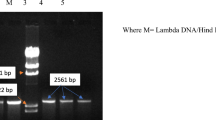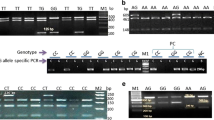Abstract
Na+/K+-ATPase is an integral membrane protein composed of a large catalytic subunit (alpha), a smaller glycoprotein subunit (beta), and gamma subunit. The beta subunit is essential for ion recognition as well as maintenance of the membrane integrity. Present study was aimed to analyze the expression pattern of ATPase beta subunit genes (ATPase B1, ATPase B2, and ATPase B3) among the crossbred bulls under different ambient temperatures (20–44 °C). The present study was also aimed to look into the relationship of HSP70 with the ATPase beta family genes. Our results demonstrated that among beta family genes, transcript abundance of ATPase B1 and ATPase B2 is significantly (P < 0.05) higher during the thermal stress. Pearson correlation coefficient analysis revealed that the expression of ATPase Β1, ATPase B2, and ATPase B3 is highly correlated (P < 0.01) with HSP70, representing that the change in the expression pattern of these genes is positive and synergistic. These may provide a foundation for understanding the mechanisms of ATPase beta family genes for cellular thermotolerance in cattle.



Similar content being viewed by others
References
Avila J, Alvarez de la Rosa D, González-Martínez LM, Lecuona E, Martín-Vasallo P (1998) Structure and expression of the human Na,K-ATPase β2-subunit gene. Gene 208:221–227
Basiricò L, Morera P, Primi V, Lacetera N, Nardone A, Bernabucci U (2011) Cellular thermotolerance is associated with heat shock protein 70.1 genetic polymorphisms in Holstein lactating cows. Cell Stress Chaperones 16(4):441–448
Beatty DT, Barnes A, Taylor E, Pethick D, McCarthy M, Maloney SK (2006) Physiological responses of Bos taurus and Bos indicus cattle to prolonged, continuous heat and humidity. J Anim Sci 84:972–985
Beckham JT, Mackanos MA, Crooke C, Takahashi T, O'Connell-Rodwell C, Contag CH, Jansen ED (2004) Assessment of cellular response to thermal laser injury through bioluminescence imaging of heat shock protein 70. Photochem Photobiol 79:76–85
Bradford MM (1976) A rapid and sensitive method for the quantitation of microgram quantities of protein utilizing the principle of protein-dye binding. Anal Biochem 72:248–254
Collier RJ, Collier JL, Rhoads RP, Baumgard LH (2008) Invited review: genes involved in the bovine heat stress response. J Dairy Sci 91:445–454
Dangi SS, Gupta M, Maurya D, Yadav VP, Panda RP, Singh G, Mohan NH, Bhure SK, Das BC, Bag S, Mahapatra R, Sharma GT, Sarkar M (2012) Expression profile of HSP genes during different seasons in goats (Capra hircus). Trop Anim Health Prod 44:1905–1912
Dangi SS, Gupta M, Nagar V, Yadav VP, Dangi SK, Shankar O, Chouhan VS, Kumar P, Singh G, Sarkar M (2014) Impact of short-term heat stress on physiological responses and expression profile of HSPs in Barbari goats. Int J Biometerol 58(10):2085–2093
Deb R, Sajjanar B, Singh U, Kumar S, Brahamane MP, Singh R, Sengar G, Sharma A (2013) Promoter variants at AP2 box region of HSP70.1 affect thermal stress response and milk production traits in Frieswal cross bred cattle. Gene. doi:10.1016/j.gene.2013.09.037
Emanuel JR, Garetz S, Stone L, Levenson R (1987) Differential expression of Na+,K+-ATPase alpha- and beta subunit mRNAs in rat tissues and cell lines. Proc Natl Acad Sci U S A 84:9030–9034
Hernando N, Martin-Vasallo P, Ghosh S, Ghosh PK, Swaroop A, Coca-Prados M (1994) Nucleotide sequence of a cDNA for the β2 subunit isoform of Na+, K+-ATPase from human retina. Biochim Biophys Acta Biomembr 1189:109–111
Horowitz M (2002) From molecular and cellular to integrative heat defense during exposure to chronic heat. Comp Physiol Biochem 13:475–483
Kishore A, Sodhi M, Kumari P, Mohanty AK, Sadana DK, Kapila N, Khate K, Shandilya U, Kataria RS, Mukesh M (2014) Peripheral blood mononuclear cells: a potential cellular system to understand differential heat shock response across native cattle (Bos indicus), exotic cattle (Bos taurus), and riverine buffaloes (Bubalus bubalis) of India. Cell Stress Chaperones 19(5):613–621
Köksoy AA (2002) Na+, K+-ATPase: a review. J Ankara Med Sch 24:73–82
Levy B, Gibot S, Franck P, Cravoisy A, Bollaert PE (2005) Relation between muscle Na+K+ ATPase activity and raised lactate concentrations in septic shock: a prospective study. Lancet 365:871–875
Lindquist S (1986) The heat-shock response. Annu Rev Biochem 55:1151–1191
Liu Y, Li D, Huixia Li H, Zhou X, Wang G (2011) A novel SNP of the ATP1A gene is associated with heat tolerance traits in dairy cows. Mol Biol Rep 38:83–88
Livak KJ, Schmittgen TD (2001) Analysis of relative gene expression data using real-time quantitative PCR and the 2[-Delta Delta C(T)] Method. Methods 25:402–408
Mishra A, Hooda OK, Singh G, Meur SK (2010) Influence of induced heat stress on HSP70 in buffalo lymphocytes. J Anim Physiol Anim Nutr 95:540–544
Morel P, Tallineau C, Pontcharraud R, Piriou A et al (1998) Effects of 4-hydroxynonenal, a lipid peroxidation product, on dopamine transport and Na+/K+ ATPase in rat striatal synaptosomes. Neurochem Int 33:531–540
Narayan U, Singh DV, Sharma RJ (2007) Physiological responses in Holstein-Friesian crossbred lactating cows under heat stress ameliorating treatments. Indian J Anim Res 41(2):130–133
Patir H, Upadhyay RC (2010) Purification, characterization and expression kinetics of heat shock protein 70 from Bubalus bubalis. Res Vet Sci 88:258–262
Pearce SC, SC Harris AJ, Gabler NK, Baumgard LH (2011) Effects of heat stress on Na+/K+ATPase activity in growing pigs. J Anim Sci 89(E-Suppl 1):596
Pelham HRB (1986) Speculations on the functions of the major heat shock and glucose-regulated proteins. Cell 46:959–961
Rolfe DF, Brown GC (1997) Cellular energy utilization and molecular origin of standard metabolic rate in mammals. Physiol Rev 77(3):731–758
Song S, Huo J, Yuan F, Ou-Yang Y, Li DL, Yuan YY, Chen T, Li LJ, Miao YM (2014) Molecular cloning, sequence characterization, and gene expression profile of a novel water buffalo (Bubalus bubalis) gene: Na+, K+-ATPase β2-subunit (ATP1B2). Archiv Tierzucht 57(15):1–12
Vague P, Coste TC, Jannot MF, Raccah D, Tsimaratos M (2004) C-peptide, Na+,K+-ATPase, and diabetes. Exp Diabesity Res 5(1):37–50
Wang Z, Wang G, Huang J, Li Q, Wang C, Zhong J (2011) Novel SNPs in the ATP1B2 gene and their associations with milk yield, milk composition and heat-resistance traits in Chinese Holstein cows. Mol Biol Rep 38:1749–1755
Wang Z, Huang J, Zhong J, Wang G (2012) Tissue-specific alternative splicing and expression of ATP1B2 gene. Afr J Biotechnol 11:9485–9495
Acknowledgments
The authors are thankful to the Director, ICAR-CIRC, Meerut and ICAR-NIASM, Baramati for providing the necessary facilities to conduct the present work. Authors are also thankful to the Military Farm, Meerut, Uttar Pradesh, India for providing experimental animals.
Author information
Authors and Affiliations
Corresponding author
Rights and permissions
About this article
Cite this article
Deb, R., Sajjanar, B., Singh, U. et al. Understanding the mechanisms of ATPase beta family genes for cellular thermotolerance in crossbred bulls. Int J Biometeorol 59, 1783–1789 (2015). https://doi.org/10.1007/s00484-015-0986-x
Received:
Revised:
Accepted:
Published:
Issue Date:
DOI: https://doi.org/10.1007/s00484-015-0986-x




